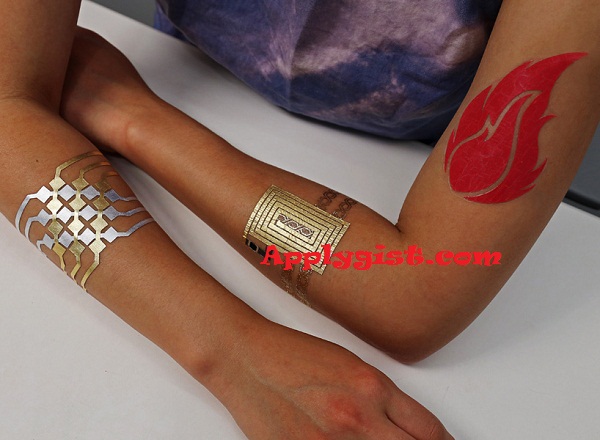Yes MIT’s ‘duoskin’ is a fabrication process that enables anyone to create customized functional tattoos that can be attached directly on their skin, like electical temporary tattoos
How to download and Activate IDM version 6.28 for free Usage
they use gold metal leaf—a material that’s cheap, skin-friendly, and robust for everyday wear—and provide three different types of on-skin interfaces: sensing touch input, displaying output, and wireless communication. this process draws from the aesthetics found in metallic jewelry-like temporary tattoos to create on-skin devices which resemble jewelry
MIT’s ‘duoskin’ devices allow people to control their mobile devices, display information, and store date on their skin while serving as a statement of personal style. they can be designed in any color and shape, and they can go anywhere on the body. its metallic tattoo process can store and share data wirelessly with your smartphone or other such device via near-field communication (NFC) technology. at the same time, its ‘touch input’ technology enables you to use your skin like a trackpad for activities such as adjusting the volume on your smartphone, turning on lights, or writing text. additionally, the tattoo can show information, including your mood and the weather.
Tech Inventions – Would YOU ride this space age copter?
fashion designer chris bevans, a former MIT media lab director’s fellow, heard about the project and he saw an interesting connection btween his dyne brand on wirelss tech in clothing and ‘duoskin’s’ NFC tags. in january this year he decided to reach out to the ‘duoskin’ team to talk about a collaboration for his new york fashion week show. cindy hsin-liu kao, the PhD student behind the project, decided it would be an interesting design experiment to customize ‘duoskin’ for a menswear fashion show—focusing on the ability to personalize it for any wearer, be it high-end or street style. the team custom-designed and fabricated ten NFC tags and shipped them to chris before his new york show so he could incorporate them into his new clothing line.
in deciding whether or not to pursue a collaboration, cindy felt it was important to revisit the central vision that drove the project in the first place: the ability to customize the technology for any person; not just those who would wear jewelry-style tattoos. then, it needed to deploy this in the real-world: the teams collaboration with chris bevans was a test of immediate deployment, and it was a success.

the team experienced the frenetic pace of a fashion show, and the level of detail and planning involved, plus discovered that they shared some experiences with fashion designers: as researchers, they for months on a project in the hopes of getting it published and allocated 15-20 minutes to present at a conference. similarly, with fall/winter and spring/summer fashion shows each year, designers are allocated an average of 45 minutes to share their curated ideas with the world.
the ‘duoskin’ research team believes that in the future, on-skin electronics will converge towards the user friendliness, extensibility, and aesthetics of body decorations, integrated to such an extent that the interface technology has apparently disappeared.






